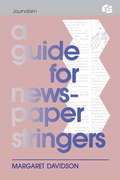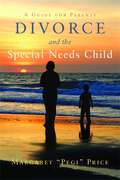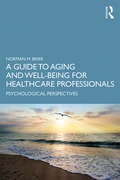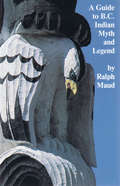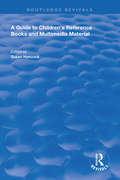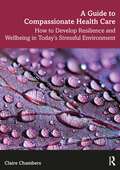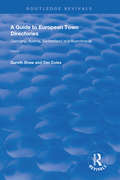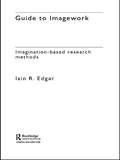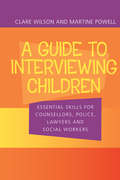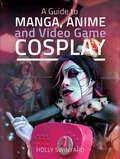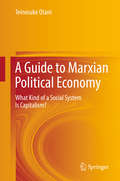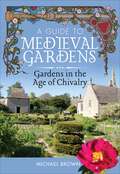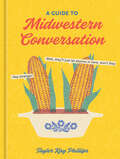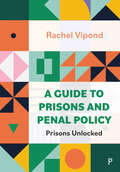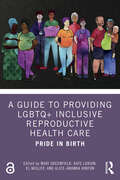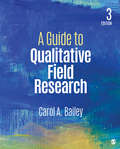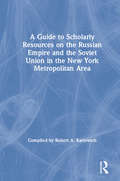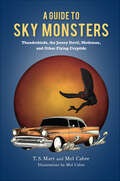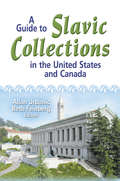- Table View
- List View
A Guide for Newspaper Stringers (Routledge Communication Series)
by Margaret DavidsonFirst Published in 1990. Routledge is an imprint of Taylor & Francis, an informa company.
A Guide for Parents Divorce and the Special Needs Child
by Margaret Pegi" PriceGoing through a divorce is always tough, but when a child with special needs is involved it can be especially challenging. This book takes a clear and comprehensive look at every aspect of the legal divorce process, and addresses all of the legal issues that divorcing parents of children with special needs face. The author guides parents through the initial hurdles of choosing the right lawyer for their case, and explains exactly how to work with them to achieve the best possible outcome for all concerned. From agreeing upon child custody arrangements that meet the particular needs of the child, to making provision for child support payments, gathering together the documentation needed to prove a case, and dealing with financial issues such as debts and property distribution, no aspect of divorce is left uncovered. A set of checklists is included to ensure that parents consider everything they need to, and the book concludes with a useful list of further resources. Written by an experienced family lawyer who went through her own divorce when her son, who has autism, was six, this book offers much-needed guidance to divorcing parents of children with a variety of special needs.
A Guide to Aging and Well-Being for Healthcare Professionals: Psychological Perspectives
by Norman M. BrierThis book provides practical evidence-based strategies that will help clinicians across a broad range of disciplines to address and discuss the main issues an aging person is likely to face and overcome if they are to maintain a sense of well-being as they age. Based on an extensive body of research, the relevant up-to-date knowledge for each topic is concisely presented, followed by practical, concrete, evidence-based suggestions as to how a healthcare provider might acknowledge and create a partnership with their clients to help the person increase their sense of well-being. Each chapter contains a list of key terms, a summary, and case examples that illustrate in realistic and humanistic ways how a person might present the concern being addressed and intervene. The specific challenges associated with aging that are addressed include: anxiety attached to an increasing awareness of mortality; retirement; the increasing number of losses of significant others; regrets; memory loss; the arrival of old-old age and feelings of loneliness, mattering insufficiently, and a loss of purpose; and finally, dealing with imminent death. This book is suitable for all health professionals who provide clinical services or advice to older adults including physicians (i.e. particularly in the specialties of internal medicine, family medicine, geriatrics, and geriatric psychiatry), nurses, social workers, psychologists, physical therapists, occupational therapists, and audiologists.
A Guide to Argumentative Research Writing and Thinking: Overcoming Challenges
by Arnold WentzelResearch is difficult. Even though students are trained in the basic research methodology skills, when confronted with research writing, it feels to them as if they enter a bizarre world, with its own language and conventions, where it is hard to get things right. This book translates the apparent complexities of research writing into everyday ideas, language and skills, and will enable novice researchers to start overcoming the major stumbling blocks immediately. This book focuses only on the greatest challenges in research writing, specifically those that supervisors find most difficult to explain to novice researchers. These challenges include both basic and more complex skills, such as: finding original research contributions; establishing one’s voice while drawing on other authors; turning a vague idea into a feasible research question; generating literature reviews that are original in themselves; and avoiding list-like writing when discussing the research methodology. Wentzel shows that it is easier to overcome these challenges, not with lists of prescriptions that are difficult to remember while writing, but rather by cultivating an argumentative mindset. Not only is such a mindset much easier to maintain, but it offers a central point around which one can organise any difficult writing task. The book shows how to use the argumentative mindset to approach every important writing challenge. It translates all the necessary skills into jargon-free language using a variety of visuals and simple step-by-step procedures that will enable any person to read the book quickly and start writing immediately. The book is accompanied by a website containing an instructor’s manual with guidance on the teaching and assessment of research writing, as well as lecture slides.
A Guide to B.C. Indian Myth and Legend
by Ralph MaudBoas, Teit, Hill-Tout, Barbeau, Swanton, Jenness, the luminaries of field research in British Columbia, are discussed here in A Guide to B.C. Indian Myth and Legend, and their work in Indian folklore evaluated. Other scholars, amateurs and Native informants of the past and present are given ample consideration, making this book a comprehensive survey of myth collecting in B.C. The aim is to reveal the true extent of this neglected body of world literature, and to begin to sort out the more valuable texts from those damaged in transmission. A Guide to B.C. Indian Myth and Legend is a valuable reference tool for beginning or advanced students of anthropology, and an absorbing look at the research process itself.
A Guide to B.C. Indian Myth and Legend
by Ralph MaudBoas, Teit, Hill-Tout, Barbeau, Swanton, Jenness, the luminaries of field research in British Columbia, are discussed herein, and their work in Indian folklore evaluated. Other scholars, amateurs, and Native informants of the past and present are given consideration, making this book a comprehensive survey of myth collecting in B.C. a valuable reference tool for beginning or advanced students of anthropology.
A Guide to Biblical Sites in Greece and Turkey
by Clyde E. Fant Mitchell G. ReddishIn A Guide to Biblical Sites in Greece and Turkey, two well-known, well-traveled biblical scholars offer a fascinating historical and archaeological guide to these sites. The authors reveal countless new insights into the biblical text while reliably guiding the traveler through every significant location mentioned in the Bible. The book completely traces the journeys of the Apostle Paul across Turkey (ancient Asia Minor), Greece, Cyprus, and all the islands of the Mediterranean. <p><p>A description of the location and history of each site is given, followed by an intriguing discussion of its biblical significance. Clearly written and in non-technical language, the work links the latest in biblical research with recent archaeological findings. A visit to the site is described, complete with easy-to-follow walking directions, indicating the major items of archaeological interest. Detailed site maps, historical charts, and maps of the regions are integrated into the text, and a glossary of terms is provided.
A Guide to Children's Reference Books and Multimedia Material (Routledge Revivals)
by Susan HancockFirst published in 1998 , A Guide to Children’s Reference Books and Multi Material provides essential information on over 250 children’s reference products for parents, teachers and librarians wishing to purchase the best books and multimedia material in the late 90’s.
A Guide to Compassionate Healthcare: How to Develop Resilience and Wellbeing in Today’s Stressful Environment
by Claire ChambersA Guide to Compassionate Health care looks at how to maintain wellbeing in today’s challenging healthcare environments, enabling practitioners to make a positive difference to the care environment whilst providing compassionate care to patients.
A Guide to Essential Human Services (2nd edition)
by Frederic G. ReamerThis book provides useful information on local, state, and government assistance programs and is beneficial to social workers, social work educators, and agencies providing services to individuals which include health care services, addictions, sexual orientation, family life education, children and adolescents, military personnel and veterans, immigrants and refugees, education and literacy, employment assistance, and legal services and dispute resolution, etc.
A Guide to European Town Directories: Volume One - Germany, Austria, Switzerland and Scandinavia. (Routledge Revivals)
by Gareth Shaw Tim ColesFirst published in 1997, European Directories is a major resource guide for urban historians and historical geographers. It provides a detailed bibliography of all directories published and available in major libraries throughout Germany, Austria, Switzerland, Denmark and Scandinavia. In addition, the book provides an account of the evolution of town directories, as well as giving an analysis of directory reliability and coverage. Researchers will also find an extensive bibliography for each country of literature that has utilized directory information in historical studies. The second volume includes France and southern Europe. The whole provides the first European-wide resource for those undertaking urban historical studies.
A Guide to Imagework: Imagination-Based Research Methods
by Iain EdgarA Guide to Imagework is a pioneering guide to a new trend in ethnographic research: the use of imaginative, experiential methods such as dreamwork, artwork, Gestalt theory and psychodrama. Originating in group counselling and psychiatric therapy, imagework techniques explore subjects' imaginative resources to reveal unconscious knowledge about identity, belief and society. They are ideal for accessing rich qualitative data about how individuals and cultures function. Iain Edgar, a leading specialist on ethnographic method, has condensed top-level research theory on imagework into this handy practical manual. Complete with case studies and examples, hands-on tips and guidance on methods and ethics, it is an ideal starting point for any imagework project.
A Guide to Interviewing Children: Essential Skills for Counsellors, Police Lawyers and Social Workers
by Claire Wilson Martine PowellChildren may be witnesses to crimes or accidents, or suspected victims of abuse or neglect, or they may be involved in some form of legal action such as custody cases. In these situations, they may need to be interviewed formally, and if this is not done properly, incorrect or inadequate information may be recorded or the child's position may not be correctly represented later in court. In cases of child abuse, the child may not be the only witness, and the quality of their verbal evidence is critical.A Guide to Interviewing Children is a practical guide the evidential interviewing techniques needed by a range of professionals: social workers, forensic psychologists, lawyers, police and teachers. It outlines basic techniques, explains how to deal with children of different ages (from pre-school to fifteen years), how to deal with parents, the particular issues of sexual abuse, handling multiple interviews of one child and so on. It is written for an international readership, and will be more practical and cover a broader range of contexts than the other titles currently available.
A Guide to Manga, Anime and Video Game Cosplay
by Holly SwinyardDo you find yourself sat at home wishing you could be in your favorite video game? Or dream of a time when you pretended you were Sailor Moon? Or do you want to embody your Dungeons and Dragons character for real? What’s holding you back? Maybe you need to introduced to cosplay! Cosplay is a phenomenon that is taking over the world. If you haven’t seen it yet, have you not been looking at social media? Cosplay is a mix of exciting craft skills, heady escapism and passion for pop culture that lets you be whoever you want, whenever you want. Cosplay has made its way into TV shows and documentaries, been included as part of film premieres and video game launches, it’s even referenced in the comics, manga and media it comes from! Talk about meta. But what is this super popular hobby? Well, pick up this book, and it’s twin A Guide to Movie and TV Cosplay, to get all the answers. Because it’s more than just dressing up, promise. With a little bit of help from this handy, dandy guide to cosplay, you can get stuck in. Learn about the history of the hobby (it’s been around longer than you’d think!), where it came from and how it got to be the way it is now, get your head around making and designing costumes, find out how about all the amazing skills people are using to make these costumes, and perhaps even try a few yourself. Who knows, you might be rocking out as Astro Boy, Chris Redfield or All Might at the next big comic con! So why not give it a try and play make believe for a day.
A Guide to Marxian Political Economy: What Kind Of A Social System Is Capitalism?
by Teinosuke OtaniThis textbook offers a comprehensive guide to the systematic structure of capitalism, while at the same time introducing readers to all three volumes of Marx’s Capital. Based on his extensive expertise on Marx’s critique of political economy, the author reveals the specific structure of production in capitalist societies and explicates what sets this system apart from other modes of production. Marx’s political economy is explained in a systematic and easy-to-understand manner, using numerous illustrative diagrams to complement the text. This textbook will appeal to all students and scholars looking for a more comprehensive, systematic and theoretical explanation of capitalism, equipping them with a solid theoretical understanding of its core structure.
A Guide to Medieval Gardens: Gardens in the Age of Chivalry
by Michael Brown&“A fascinating account of formal gardens during the middle ages,&” including plants and their uses, features, tools, cultivation techniques, and more (Books Monthly). Medieval gardens usually rate very few pages in the garden history books. The general perception is still of small gardens in the corner of a castle. Recent research has shown that the gardens were larger than we previously believed. This book contains information and pictures that have not been generally available before, including the theory and practice of medieval horticulture. Many features of later gardens were already a part of medieval gardens. The number of plants was limited, but was still no less than many modern gardeners use in their own gardens today. Yet medieval gardens were imbued with meaning. Whether secular or religious, the additional dimension of symbolism, gave a greater depth to medieval gardens, which is lacking in most modern ones. This book will be of interest to those who know little about medieval gardens and to those with more knowledge. It contains some of the vast amount of research that the author carried out to create the medieval gardens at the Prebendal Manor, Nassington, Northamptonshire. The author has tried to use previously unused sources and included his own practical experience of medieval gardening methods that he carried out to maintain the gardens. &“Beautifully illustrated . . . a fascinating read for the armchair gardener as well as the more practical variety . . . The author draws on a wide range of sources: herbals, animal management, medieval manuals, illuminated manuscripts, account books, poems, paintings, and tapestries.&” —The Ricardian Bulletin
A Guide to Midwestern Conversation
by Taylor Kay PhillipsLearn (and love) the language of the landlocked in this bitingly funny illustrated guide to the common phrases and sentiments of the American Heartland, from the author of the McSweeney&’s series &“A Guide to Midwestern Conversation.&”If you end an evening by slapping your thighs and saying, &“Welp, I&’ll go ahead and get outta your hair,&” then you don&’t need this guide, but you sure as heck might like it. Full of common Midwestern phrases (and what they really mean behind the friendly facade), A Guide to Midwestern Conversation is an affectionate, self-deprecating look at the language of a people long defined by their kindness and reduced to their voting patterns. Written by born-and-bred Midwesterner Taylor Kay Phillips, it&’s a wink, a hug, and a firm handshake (with eye contact) to the millions of Americans who say soda and pop interchangeably and grew up doing tornado drills in school.Discover Midwestern conversational staples like: How to announce that you hate something beyond comprehension (&“I didn&’t really care for it&”) What counts as &“a short drive&” (less than eight hours) Sports talk (starts early, doesn&’t end till we&’re six feet under)Describing the ultimate dream home (&“It&’s got a finished basement&”)An ode to the Garage FridgeIncluding an array of guides, tips, and profiles of all the states included, A Guide to Midwestern Conversation is guaranteed to make Midwesterners (and their friends) laugh out loud, nod their heads, and ask if &“anyone needs anything real quick while I&’m up.&”
A Guide to Prisons and Penal Policy: Prisons Unlocked
by Rachel VipondUnderstanding prisons and the policies surrounding them is of fundamental importance to students and practitioners of criminology and related fields. This concise and accessible guide offers a compendium of key information, theories, concepts, research and policy, presenting a rounded and critical overview of the prison system in England and Wales. Covering the historical and contemporary context of prisons, the text guides the reader through the work of prison officers, a tour of international prisons and how prison life is experienced by different groups, such as women. Focusing on the experiences of stakeholder groups and the themes of power, legitimacy and rehabilitation, the book concludes with an overview of the future challenges for prisons. Each chapter includes key learning features: • end of chapter questions; • definitions of key terms and concepts; • examples and illustrative case studies; • learning outcomes; • summary boxes of major research studies and further reading.
A Guide to Providing LGBTQ+ Inclusive Reproductive Health Care: Pride in Birth
by Mari Greenfield Kate Luxion El Molloy Alice-Amanda HintonThis evidence-based guide brings together a wide range of information and practical tools for midwives, obstetricians, nurses, health visitors and birthworkers, empowering them to provide safe and compassionate care throughout the reproductive journeys of lesbian, gay, bisexual, transgender and queer (LGBTQ+) people. This book may also be helpful to LGBTQ+ people in their own reproductive journeys.Throughout history, in cultures around the world, LGBTQ+ people have become pregnant, sought abortion care, miscarried, experienced infertility, given birth, and made decisions about infant feeding. Their reproductive journeys are increasingly visible, reflecting the changing social and legal recognition of sexual and gender minority people as parents. LGBTQ+ people require support during these significant life events which is appropriate, expert, and meets their needs. However, healthcare professionals and birthworkers may not always be confident in working with these clients and may lack understanding of LGBTQ+ clients’ experiences. There is also often insufficient attention paid to differences in the LGBTQ+ non-gestational parents' experiences. Taking an interdisciplinary approach, this book brings together up-to-date research findings from a range of fields including medicine, psychology, sociology, law and public health, to provide a knowledge base and tools to support clients at different stages of pregnancy and parenthood. The book follows the reproductive journey, moving from pre-conception and fertility research, through pregnancy and birth, to postnatal physical and mental healthcare. It also addresses termination care and perinatal loss.The chapters contain vignettes to personalise the issues discussed, highlights key practice recommendations, and suggestions for further reading. This is an essential guide for student midwives and medical students, as well as health visitors, midwives and obstetricians in practice.The Open Access version of this book, available at http://www.taylorfrancis.com, has been made available under a Creative Commons [Attribution-Non Commercial-No Derivatives (CC BY-NC-ND)] 4.0 license.
A Guide to Qualitative Field Research
by Carol R. BaileyA Guide to Qualitative Field Research provides readers with clear, practical, and specific instructions for conducting qualitative research in the field. In the expanded Third Edition, Carol A. Bailey gives increased attention to the early and last stages of field research, often the most difficult: selecting a topic, deciding upon the purpose of your research, and writing the final paper, all in her signature reader-friendly writing style. This edition features research examples from graduate and undergraduate students to make examples meaningful to fellow students; a new "Putting It All Together" feature, with examples of how different parts of the research process interact; and more emphasis on the "nuts and bolts" of research, such as what to include in an informed consent form, a proposal, and the final paper.
A Guide to Qualitative Field Research
by Carol R. BaileyA Guide to Qualitative Field Research provides readers with clear, practical, and specific instructions for conducting qualitative research in the field. In the expanded Third Edition, Carol A. Bailey gives increased attention to the early and last stages of field research, often the most difficult: selecting a topic, deciding upon the purpose of your research, and writing the final paper, all in her signature reader-friendly writing style. This edition features research examples from graduate and undergraduate students to make examples meaningful to fellow students; a new "Putting It All Together" feature, with examples of how different parts of the research process interact; and more emphasis on the "nuts and bolts" of research, such as what to include in an informed consent form, a proposal, and the final paper.
A Guide to Scholarly Resources on the Russian Empire and the Soviet Union in the New York Metropolitan Area
by Robert A. KarlowichIdentifies collections held by public and university libraries, historical societies, and other institutions, as well as private collections, with material relating to any subject and historical period, and to the widest geographical area under imperial or Soviet rule. Includes movements for example
A Guide to Self-Help Workbooks for Mental Health Clinicians and Researchers
by Luciano L'AbateNever has the need for a compendium of self-help workbooks been so great! From the founder of the world&’s first PhD program in Family Psychology comes an extensive guide to nearly all of the mental health workbooks published through 2002. Placed together in one volume for the first time, A Guide to Self-Help Workbooks for Mental Health Clinicians and Researchers includes reviews and evaluates the complexity of each workbook in regards to its form, content, and usability by the client. From abuse to women&’s issues, this annotated bibliography is alphabetized by author, but can also be researched by subject. While self-help workbooks are currently not as popular or as mainstream as self-help books and video, that could soon change. Self-help workbooks are versatile, cost-effective, and can be mass-produced. The workbook user is active rather than passive, and the mental healthcare worker can analyze a more personal response from the user, whether in the office or via the Internet. A Guide to Self-Help Workbooks for Mental Health Clinicians and Researchers brings these workbooks together into one sourcebook to suit anyone&’s needs. Each self-help workbook is reviewed according to specific criteria: contents structure specificity goal level of abstraction a subjective evaluation usually concludes the review of the workbook A Guide to Self-Help Workbooks for Mental Health Clinicians and Researchers also includes: an in-depth introduction discussing the need for workbooks in mental health practices indices for subject as well as author an address list of the publishing houses for the workbooks annotated in the bibliography an Informed Consent Form to verify compliance with ethical and professional regulations before administering a workbook to a client A Guide to Self-Help Workbooks for Mental Health Clinicians and Researchers offers you a complete resource to self-help workbooks for all mental health subjects. Dr. L&’Abate&’s highly selective review process helps you find exactly what you need. This unique sourcebook is vital for mental health clinicians, counselors, schoolteachers, and college and graduate students.
A Guide to Sky Monsters: Thunderbirds, the Jersey Devil, Mothman, and Other Flying Cryptids
by T. S. Mart Mel CabreWhen a dark shadow passes overhead, do you stop? Or do you run? Infamous sky monsters have haunted our imaginations for centuries. The Thunderbird, steeped in Native American folklore, supposedly controls evil by throwing lightning. The Jersey Devil is said to roam the Pine Barrens of South Jersey, terrorizing anyone who crosses its path. And the cryptic warnings of Mothman have worried residents of Point Pleasant, West Virginia, since the 1960s. In A Guide to Sky Monsters: Thunderbirds, the Jersey Devil, Mothman, and Other Flying Cryptids, authors T. S. Mart and Mel Cabre introduce 20 flying cryptids with legends that span the United States. With 70 hand-drawn illustrations, A Guide to Sky Monsters details our fascination with these creatures and describes both historical evidence found in the fossil record and the specifics of modern-day sightings. By studying the fact, fiction, and pop culture surrounding these notorious beasts, Mart and Cabre help us lean into the question, "What if?"A Guide to Sky Monsters, perfect for the believer and skeptic alike, addresses the wider truths about flying cryptids and leaves us all to wonder whether that breeze was the wind or a wing.
A Guide to Slavic Collections in the United States and Canada
by Allan Urbanic Beth FeinbergGet access to the Slavic and East European research materials you needA Guide to Slavic Collections in the United States and Canada presents up-to-date information on 85 North American libraries that house Slavic and East European research materials, providing current details on recent acquisitions, developments in collection policies, and changes in contact information. Using individual entries written by each institution&’s librarian or archivist, you&’ll save valuable time and effort in your search for resources on Russia and the rest of the former Soviet Union, Poland, the Czech and Slovak Republics, the former Yugoslavia, the Baltic countries, Bulgaria, Albania, Hungary, Romania, and the Sorbs in Germany. This unique book includes facts and figures on special collections, finding aids, catalogs, Web access, and bibliographies for further readings.A Guide to Slavic Collections in the United States and Canada examines collections available at public libraries, governmental libraries, special collections, and university libraries. Edited by Dr. Allan Urbanic, Librarian for Slavic and East European Collections at the University of California, Berkeley, and Slavic Collection Manager at the University of California, Santa Barbara, and Beth Feinberg, Slavic Catalog Librarian at the University of California, Los Angeles, the book lists current and retrospective materials collected in print, microform, and electronic formats, and includes monographs, serial publications, reference works, dissertations, and conference proceedings. Entries for A Guide to Slavic Collections in the United States and Canada include: access policy for visits general collection description special collection description online catalog archive collections size of collection percent of collection in vernacular language electronic resources and much more!A Guide to Slavic Collections in the United States and Canada is an essential, time-saving resource for librarians and academics looking for research materials.
